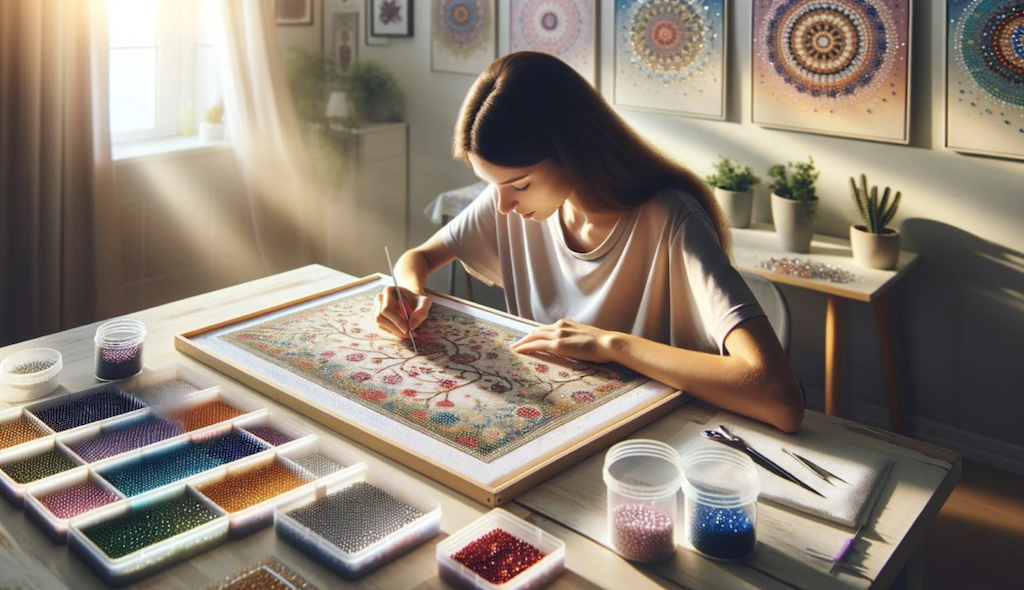
Disclosure – this is a collaborative post.
Diamond painting has emerged as a captivating hobby that combines the precision of cross-stitch with the sparkle of sequins. For beginners keen to start creating their shimmering masterpieces, understanding the essentials regarding tools and materials is the first step. A diamond painting kit typically includes everything needed to dive into this craft, often praised as a therapeutic and satisfying creative outlet.
The basic tools required for diamond painting are simple yet vital for the experience. Each starter kit should contain an adhesive canvas marked with numbers or symbols correlating to the diamond colors, much like a map. Faceted resin diamonds, also known as drills, bring the canvas to life with their shine and are applied using a stylus or penlike tool. Adhesive wax or gel is used to pick up the diamonds, and a tray helps keep these tiny components organized during crafting. For those exploring diamond painting for beginners, these materials form the foundation of any project.
Key Takeaways
- Diamond painting combines cross-stitch precision with sequin sparkle, offering a satisfying craft.
- Starter kits typically include an adhesive canvas, drills, applicator tool, wax, and tray.
- Organization and correct tool use are crucial for a successful introduction to diamond painting.
Basic Tools and Materials
Beginning diamond painting requires a set of specific materials and tools to ensure an enjoyable and successful crafting experience.
Essential Diamond Painting Kits
Every beginner should start with a comprehensive diamond painting kit with all the necessary tools. These kits typically come with a pre-printed adhesive canvas, a variety of diamond drills, a diamond pen for picking up the drills, a tray to hold them, and wax or a wax pad to help the drills stick to the pen.
Choosing the Right Canvas
The canvas is the foundation of any diamond painting project. It should be constructed with quality adhesive to hold the drills securely. Canvases come with a protective film to keep the surface free of contaminants and are usually marked with a clear, easy-to-follow design guide.
Understanding Drills and Their Types
Drills are the tiny diamond-like facets that create the mosaic look. They come in two primary shapes: square and round. Square drills fit snugly together for a complete image with no gaps, while round drills are easier to place and give a more shimmery effect due to spacing.
The Role of Adhesives and Wax
Adhesives ensure that drills stick to the canvas. Pre-applied to the canvas upon purchase, the adhesive must be strong enough to hold the drills long-term. During the process, wax picks up the drills with the diamond pen. Occasionally reapplying wax to the pen tip is essential for a smooth workflow.
Advanced Techniques and Organization
Mastering diamond painting involves learning the craft and organizing tools and materials effectively. As crafters progress, they discover techniques to enhance clarity and consistency in their artwork, streamline their workspace, and properly store and display their finished pieces.
Perfecting Your Technique
Advanced crafters often employ the checkerboard technique to ensure even spacing and enhance the overall look of their diamond paintings. This step-by-step guide involves placing diamonds in alternating squares like a checkerboard and then filling in the gaps, which helps to maintain uniformity and prevents misalignment. For those working on intricate designs, alternating between full and partial drill options can add depth and texture to their work.
Organization and Storage Solutions
A well-organized workspace is vital for efficiency and comfort. Crafters should utilize storage containers that are color-coded to manage their beads efficiently. These containers come in various sizes, aiding in keeping small pieces securely and avoiding loss or mixing of colors. Diamond painting tools and trays should be easily accessible, and a clean, clutter-free area ensures a more enjoyable crafting experience.
Framing and Displaying Finished Pieces
Once a piece is completed, framing is vital to protect and prepare the artwork for display. Crafters should choose frames that complement their work’s dimensions and aesthetic. Opting for frames designed for diamond painting for beginners might provide additional convenience with pre-sized measurements and suitable depths for accommodating the beads’ height.
Troubleshooting Common Challenges
Common challenges in diamond painting include dealing with stray beads, maintaining the stickiness of canvases, and managing repetitive strain. Using a paint-by-numbers approach improves the placement of beads, while regularly covering the canvas with a protective film can preserve its adhesive quality. For comfort, ergonomic tools provide a more comfortable grip during long crafting sessions.
Conclusion
A beginner venturing into diamond painting requires a few essential tools and materials. They include diamonds or drills, a canvas with design, an applicator pen or tool, wax or adhesive, a tray for the diamonds, and tweezers for precision. These components work in harmony to facilitate the creation of sparkling, mosaic-like art pieces. Anyone can embark on this rewarding craft with these tools and produce beautiful, shimmering artworks.
Disclosure – this is a collaborative post.
